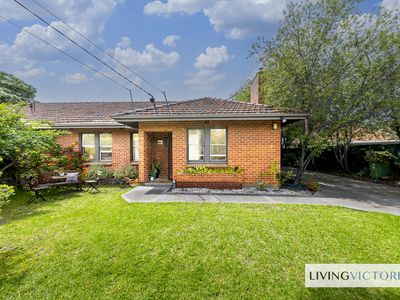Why Living Victoria?
Featured Properties
Our Team








Recently Sold
Latest News
RBA REDUCES CASH RATE TO 3.60%
In a move set to offer much-needed relief for Australian households, the Reserve Bank of Australia has reduced the official cash rate by 0.25%, lowering it from 3.85% to 3.60%. This marks the third rate cut in 2025, driven by softer-than-expected inflation figures and mounting signs of an economic slowdown. For mortgage holders, this quarter-percent reduction could translate into significant ...
Important Update: New Energy Efficiency & Safety Standards for Rental Properties
There are some important changes coming to rental property standards here in Victoria, and we want to ensure that you're across them. The Victorian Government has announced new minimum energy efficiency and safety standards that will apply to all rental properties and rooming houses over the next few years. These updates are all about making homes safer, more comfortable, and more energy effic...
RBA REDUCES CASH RATE TO 3.85%
In a move that came as no surprise to most, the Reserve Bank of Australia (RBA) has just lowered the official interest rate by 25 basis points, bringing it down to 3.85%. This follows today’s monetary policy meeting and reflects the latest economic data showing inflation is finally easing. According to the Australian Bureau of Statistics, annual trimmed mean inflation—the RBA’s go-to measure—h...
RBA HOLDS CASH RATE AT 4.10%
The Reserve Bank of Australia (RBA) has held the cash rate steady at 4.10% in its second monetary policy meeting of the year. No surprises here—this move was widely expected after February’s rate cut. RBA Governor Michele Bullock previously stated that the central bank is keeping a close eye on inflation, waiting for solid proof that it’s returning to target before making any further moves....
RBA HOLDS CASH RATE AT 4.35%
At its final meeting of 2024, the Reserve Bank of Australia kept the cash rate on hold at 4.35%. The decision was widely expected, with headline inflation trending lower. The numbers largely point towards a possible cash rate cut in the first half of 2025. Chris Weston from Pepperstone confirmed that while markets only predicted a 7% chance of a rate cut today, there is now an 87% chance of...
RBA HOLDS CASH RATE AT 4.35%
For another meeting, the Reserve Bank of Australia (RBA) held the cash rate steady at 4.35%. The last time the RBA changed the cash rate was an increase in November 2023. The move was widely expected as the RBA has made it clear it is working to get inflation back to within the target range of 2-3%. While inflation has fallen since its peak, the most recent quarterly results for June 2024 s...
RBA HOLDS CASH RATE AT 4.35%
Interest Rate Decision: The Reserve Bank of Australia (RBA) decided to maintain the country’s official interest rate at 4.35% during its May monetary policy meeting. This interest rate level has been in place since last November. Inflation Trends: The latest data from the ABS indicates that annual inflation fell to 3.6% in the March 2024 quarter. This is the fifth consecutive quarter...
RBA HOLDS CASH RATE AT 4.35%
The cash rate will remain at 4.35% following the Reserve Bank of Australia’s (RBA) March monetary policy meeting. The decision was largely expected, as the latest Australian Bureau of Statistics data showed annual trimmed mean inflation fell to 3.8% in January, down from 4.0% in December. While higher interest rates appear to be having the desired effect on the economy, RBA governor Mic...
RBA increases cash rate to 4.35%
On the back of recent concerning data around inflation, the Reserve Bank of Australia (RBA) increased the cash rate from 4.10% to 4.35%. The decision was in line with market expectations, given the RBA recently said it would “not hesitate to raise the cash rate further if there is a material upward revision to the outlook for inflation”.
RBA HOLDS CASH RATE AT 4.10%
The Reserve Bank of Australia (RBA) has left the cash rate at 4.10% for the fourth consecutive month, as many commentators had expected. While the RBA has said in the past few months that it may increase the cash rate in the future, many commentators believe that rates have now peaked. Inflation will be the key. If it keeps trending down, the RBA may refrain from making further rate hik...
RBA HOLDS CASH RATE AT 4.10%
The Reserve Bank of Australia (RBA) announced the cash rate will remain unchanged at 4.10% after its monetary policy meeting today. This marks the third consecutive meeting at which the cash rate has been held. The decision was in line with expectations, as it comes shortly after the Australian Bureau of Statistics released data showing annual inflation slowed to 4.9% in July from 5.4% in ...
Rental freeze will only leave renters out in the cold
Victoria’s real estate peak body, the Real Estate Institute of Victoria, has today launched a major advertising campaign attacking the proposed residential rental cap, outlining that the policy’s introduction will increase homelessness.The Victorian-wide print, digital, editorial, and social media campaign, backed by industry, states that while a rent freeze might save renters some money in the...
RBA HOLDS CASH RATE AT 4.10%
The Reserve Bank of Australia (RBA) kept the cash rate at 4.10% at its July monetary policy meeting. The decision comes shortly after the Australian Bureau of Statistics released data showing annual inflation fell to 5.6% in May from 6.8% in April. This suggests the central bank’s 12 previous cash rate increases are having the intended effect. Inflation still remains significantly highe...
RBA increases cash rate to 4.10%
Australia’s official interest rate is now 4.10% after the RBA lifted the cash rate by 25 basis points. With inflation unexpectedly increasing, the central bank believes more cash rate rises are essential to slow the economy further.
RBA increases cash rate to 3.85%
At its May meeting, the Reserve Bank of Australia raised the cash rate from 3.60% to 3.85%. This decision was made despite the Australian Bureau of Statistics reporting a decrease in annual inflation from 7.8% in the December quarter to 7.0% in the first three months of 2023. Nevertheless, the RBA deems the current rate of inflation to be significantly above its target range of 2-3%, necessit...
RBA HOLDS INTEREST RATES AT 3.60%
The Reserve Bank of Australia maintained the cash rate at 3.60%.This decision follows a decline in Australia's annual inflation rate from 7.4% in January to 6.8% in February, indicating that the previous interest rate increases may be having the desired effect on consumer prices.
RBA increases cash rate to 3.60%
The Reserve Bank of Australia has increased again increased the cash rate which now sits at 3.60%. This move was expected given their recent announcement of their intention to implement an additional 2 interest rate rises before the end of 2023.
Choosing an independent Real Estate Agency - What are the benefits?
Selling or leasing your home can be a significant life decision and it's important to choose the right partner to help you through the process. An independent real estate agency can provide you with several benefits that can make the process easier, quicker, and more profitable. Personalised services: Independent real estate agencies are typically smaller than larger corporate agencies, whi...
RBA increases cash rate to 3.35%
As expected, the Reserve Bank of Australia increased the official cash rate by 25 basis points to 3.35% at its first monetary policy meeting of the year. The move was the ninth rise in as many meetings and comes after Australia’s annual inflation rate reached a 30-year high of 7.8% over the December quarter.
RBA increases cash rate to 3.10%
Australia’s official interest rate is now 3.10% after the Reserve Bank of Australia lifted the cash rate by 25 basis points following today’s board meeting. The move was widely expected, as the RBA reiterated its determination to return inflation to target in its November quarterly Statement on Monetary Policy. The central bank “expects that interest rates will need to increase further” to ...
How high will interest rates rise in 2023?
Experts warning to Australians "brace for more interest rate pain in the year ahead". After the Reserve Bank of Australia (RBA) increased the cash rate to 2.85% in its Melbourne Cup Day meeting, the major banks have adjusted their forecasts for when interest rates will peak. What the Big Four banks are saying: Westpac predicts rates could go as high as 3.85% by March 2023, while ANZ forec...
How is monthly rent calculated?
More often than not, rent is typically advertised as per the weekly rate, and rental payments by the calendar month. Commonly, the mistake people make is to assume that there are 4 weeks in a month. As you may have already discovered, not every month has an equal number of days, this means that calculating your monthly rent is not as straightforward as multiplying the weekly rent by 4 or the fo...



